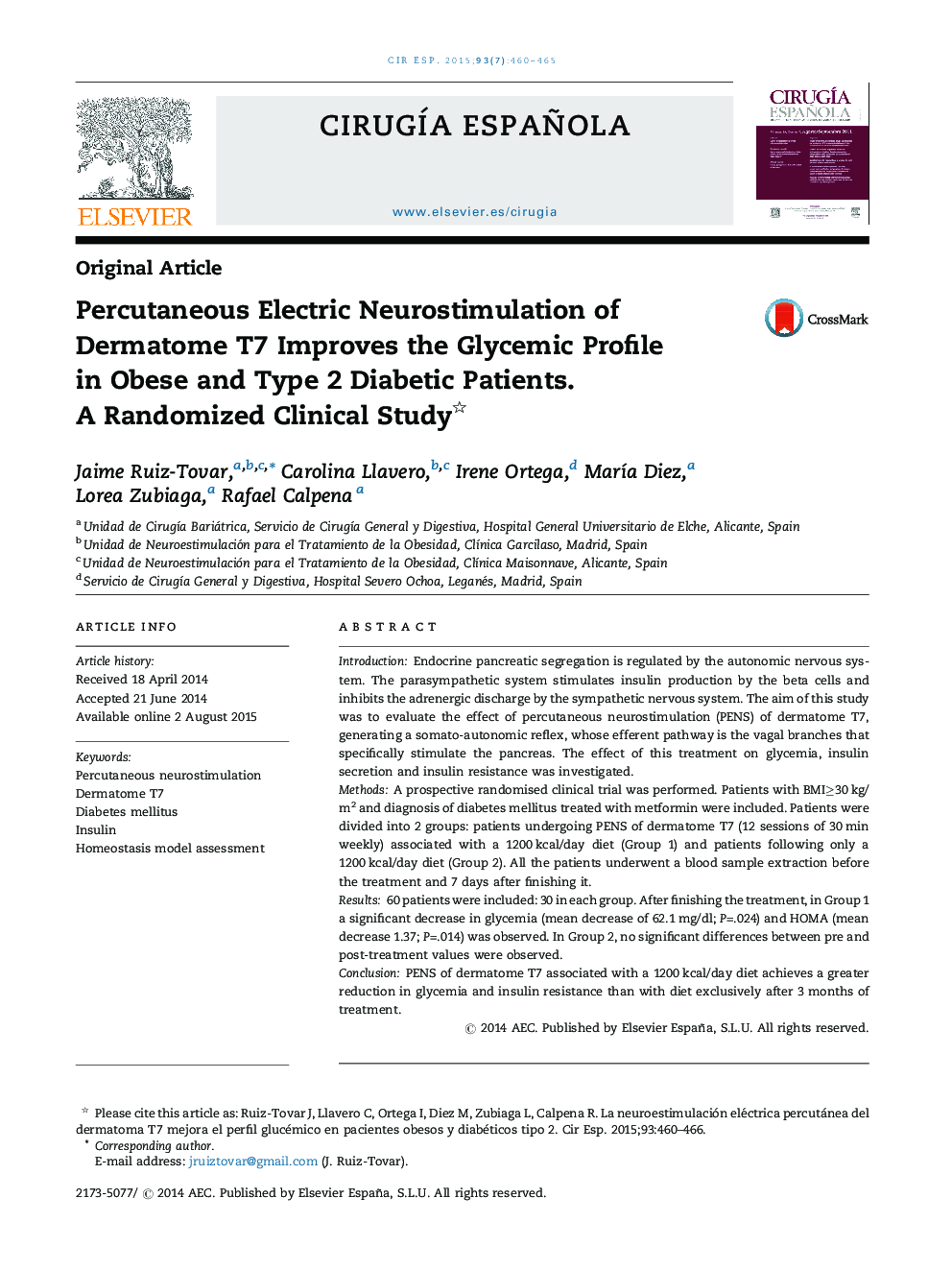| کد مقاله | کد نشریه | سال انتشار | مقاله انگلیسی | نسخه تمام متن |
|---|---|---|---|---|
| 4254623 | 1284391 | 2015 | 6 صفحه PDF | دانلود رایگان |

IntroductionEndocrine pancreatic segregation is regulated by the autonomic nervous system. The parasympathetic system stimulates insulin production by the beta cells and inhibits the adrenergic discharge by the sympathetic nervous system. The aim of this study was to evaluate the effect of percutaneous neurostimulation (PENS) of dermatome T7, generating a somato-autonomic reflex, whose efferent pathway is the vagal branches that specifically stimulate the pancreas. The effect of this treatment on glycemia, insulin secretion and insulin resistance was investigated.MethodsA prospective randomised clinical trial was performed. Patients with BMI≥30 kg/m2 and diagnosis of diabetes mellitus treated with metformin were included. Patients were divided into 2 groups: patients undergoing PENS of dermatome T7 (12 sessions of 30 min weekly) associated with a 1200 kcal/day diet (Group 1) and patients following only a 1200 kcal/day diet (Group 2). All the patients underwent a blood sample extraction before the treatment and 7 days after finishing it.Results60 patients were included: 30 in each group. After finishing the treatment, in Group 1 a significant decrease in glycemia (mean decrease of 62.1 mg/dl; P=.024) and HOMA (mean decrease 1.37; P=.014) was observed. In Group 2, no significant differences between pre and post-treatment values were observed.ConclusionPENS of dermatome T7 associated with a 1200 kcal/day diet achieves a greater reduction in glycemia and insulin resistance than with diet exclusively after 3 months of treatment.
ResumenIntroducciónLa secreción endocrina pancreática está regulada por el sistema nervioso autónomo. El sistema parasimpático estimula la producción de insulina por las células beta e inhibe la liberación adrenérgica por el sistema nervioso simpático. El objetivo del presente estudio es evaluar el efecto de la neuroestimulación percutánea (PENS) del dermatoma T7, creándose un reflejo somato-autonómico, cuya vía eferente serán las ramas del nervio vago que estimulan específicamente el páncreas. Se analizará el efecto de este tratamiento sobre la glucemia, la secreción de insulina y la resistencia a la acción de la insulina.MétodosRealizamos un estudio prospectivo aleatorizado. Se incluyeron pacientes con IMC ≥ 30 kg/m2 y diagnóstico de diabetes mellitus en tratamiento con metformina. Los pacientes fueron aleatorizados en 2 grupos: pacientes sometidos a PENS del dermatoma T7 (12 sesiones de 30 min semanales) asociado a dieta de 1.200 kcal/día (grupo 1) y pacientes que seguían una dieta de 1.200 kcal/día exclusivamente (grupo 2). A todos los pacientes se les realizó una analítica sanguínea en ayunas antes de empezar el tratamiento y a los 7 días de finalizarlo.ResultadosSe incluyeron 60 pacientes: 30 pacientes en cada grupo. Al finalizar el tratamiento en el grupo 1 se observa un descenso significativo en la glucemia (descenso medio de 62,1 mg/dl; p = 0,024) y en el HOMA (descenso medio 1,37; p = 0,014). En el grupo 2 no se observan diferencias significativas en los valores pre y postratamiento.ConclusiónLa PENS del dermatoma T7 asociada a dieta de 1.200 kcal/día produce una mayor reducción de la glucemia y de la resistencia insulínica que la obtenida solo mediante dieta tras 3 meses de tratamiento.
Journal: Cirugía Española (English Edition) - Volume 93, Issue 7, August–September 2015, Pages 460–465